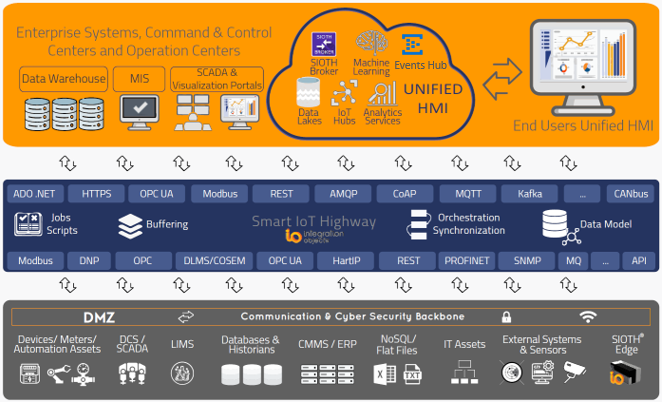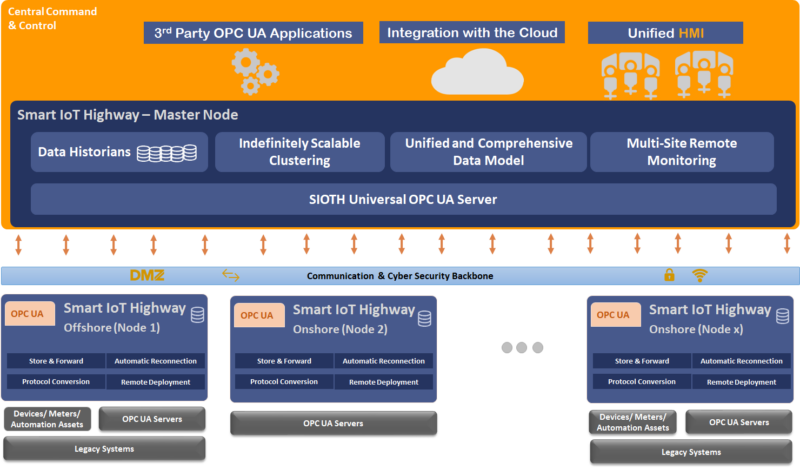SPONSORED BY: INTEGRATION OBJECTS
In modern industry, seamless communications between OT systems and IT systems are essential for efficiency and safety monitoring. This is where OPC UA (Open Platform Communications Unified Architecture) comes in, providing a standardized framework for data exchange across various industrial systems. OPC UA facilitates seamless communication between machines, devices, and software applications from various manufacturers. However, the IT-OT integration becomes significantly challenging when dealing with geographically dispersed sites, several networks, domains and even authorities. Integration Objects provides an OPC UA based solution to enable such integration while complying with the ISA 99 / IEC 62443 industrial cyber security requirements, and the different stakeholders’ policies.
Challenges in Industrial Data Integration and Archiving across Multiple Sites:
Given OPC UA’s capability to seamlessly interconnect various industrial systems, it inevitably leads to the generation of large amounts of data. Gathering and archiving such data ensures the preservation of critical data generated from various processes, machines, and systems, and enables organizations to maintain a comprehensive record for analysis, compliance, and informed decision-making. Several solutions available on the market have proven that they can handle such data archiving. However, managing and integrating data across multiple industrial sites pose unique challenges that organizations must address. Let us dive deeper:
- Scalability: managing and archiving large volumes of data from multiple sites and transferring to a centralized system can strain existing infrastructure and systems, requiring scalable solutions to handle increasing data loads efficiently.
- Cyber Security: Gathering data from multiple sites requires compliance with different network architectures as well as security policies and restrictions.
- Interoperability: Integrating data from multiple OPC UA servers and ensuring a unified data model between them presents a significant challenge. Differences in data representations, naming conventions and hierarchy across sites can hinder data integration efforts and consequently complicate the archiving process within a centralized system.
- Data Synchronization: maintaining real-time data synchronization across multiple industrial sites is crucial. However, factors such as network latency, bandwidth limitations, and communication delays can hinder the synchronization process, leading to discrepancies in data availability and quality.
- Network Latency: network latency, or the delay in data transmission between industrial sites, can significantly impact the speed and reliability of data integration resulting in delays in data delivery and even data loss.
- Legacy System Integration: When dealing with multiple sites, different maintenance strategies are involved. There are often sites that still have to maintain critical legacy systems. Integrating data from legacy OT data sources requires compatibility between modern data integration solutions and legacy systems.
- Investment: multi-site data integration and archiving generally require historians to be deployed on individual sites and in one centralized location at least. This requires an important investment in software licenses and maintenance from end users. This investment may go even higher with the increase of tags number.
- Monitoring and Management: Multi-site integration demands effective monitoring and management to oversee the performance and health of distributed systems as well as the communications statuses.
Addressing these challenges requires a holistic approach that encompasses robust data integration, synchronization, modeling mechanisms as well as flexible deployment options in terms of architecture, cyber security, scalability, and configuration.
Introducing SIOTH®: Your Gateway to Seamless Multi-Site Integration
SIOTH®, Smart IoT Highway, is an IT-OT integration platform that addresses the complexities of OPC UA data integration and archiving for multiple sites, data sources, networks and domains with efficiency and effectiveness.
SIOTH® offers a comprehensive approach to data management, seamlessly integrating data from OPC UA servers across multiple industrial sites. From data acquisition and storage to analysis and visualization, SIOTH® provides organizations with the tools and functionalities needed to harness the full potential of their industrial data. SIOTH®’s intuitive interface and flexible architecture make it easy to deploy and configure, ensuring quick and seamless integration with existing industrial systems.

SIOTH® Platform Overview
Key SIOTH® Capabilities in streamlining Data Collection and Archiving Process within Multiple Sites Integration Context:
SIOTH® offers a comprehensive solution to streamline the data archiving process and enable seamless integration across multiple industrial sites through:
- Automated Data Gathering and Archiving: SIOTH® provides seamless integration with OPC UA servers, enabling organizations to collect and archive real-time, historical data and alarms and events. Its compatibility with various OPC UA servers ensures flexibility and interoperability.
SIOTH® also provides a Universal OPC UA Server that exposes data gathered from multiple sites and multiple OPC UA Server via a single and unified OPC UA interface.
- Cyber Security: SIOTH® protects the data flowing over the network within the sites as well as between each site and the central location via data encryption and integrity capabilities. SIOTH® also provides other security features in terms of user authorization, role-based access, and high availability.
- Scalability: SIOTH® is a scalable platform that can scale up indefinitely, locally for a single site and globally interconnecting multiple sites, distribute data exchange tasks among multiple nodes and duplicate jobs and services for quick recovery post-failure.
- Historian: SIOTH® embeds by default a time-series historian to consolidate data from disparate sources into a single, centralized repository allowing organizations to access and analyze historical data seamlessly, regardless of its origin.
- Protocol Conversion: SIOTH® provides protocol conversion that facilitates seamless integration with legacy OT systems and enables the translation of the data formats to the OPC UA information model or other specific formats configured by the user.
- Flexible Data Modeling: SIOTH® offers flexible data modeling capabilities enabling organizations to define and configure their own data models that align with their specific industrial processes and requirements. This ensures data consistency between different sites and consequently enhances the accuracy of analysis and reporting.
- Advanced Rules, Workflows and Visualization: SIOTH® offers:
- Job Engine module for rules and workflows management. Rules are configured to monitor communications health with multiple sites and trigger notifications and workflows accordingly. Workflows can include corrective procedures, escalation procedures or reports generation.
- Visualization, dashboarding and SCADA module: Unified HMI, for deeper insights into data, trends, patterns, and anomalies monitoring enabling organizations to make informed decisions.
Use Case: SIOTH® for OPC UA Historian Solution for Offshore and Onshore Sites
An Oil & Gas company that operates offshore platforms and onshore processing plants equipped with various automation systems requires a robust OPC UA historian solution to manage real-time data from multiple sources and replicate a subset to an onshore central environment.
SIOTH® effectively met the needs of this requirement by implementing local OPC UA historians at each site to integrate and store real-time data. This setup facilitates replication to a centralized onshore historian and ensures dependable data management, even with diverse communication channels.
How SIOTH® Replied to Use-Case Requirements
Connectivity:
- Multi-source data aggregation: SIOTH® Universal OPC UA server seamlessly collects data from multiple OPC UA servers, centralizing them into a unified interface.
- Protocol flexibility: Supporting multiple protocols ensures compatibility with a wide range of devices and systems including legacy system.
- Reliable data integration: SIOTH® provides store and forward capabilities to ensure reliable data integration and consequently archiving, mitigating the risk of data loss during network disruptions. Data accumulated during disconnections are seamlessly transmitted to the central server once the connection is restored.
- Restoring connection without user intervention: Automatic reconnection mechanisms minimize downtime by continuously attempting to reconnect to OPC UA servers.
- Customizable reconnection policies: Organizations have the flexibility to customize reconnection and parameters.
Scalability: SIOTH® is deployed on a cluster of several nodes, where:
- Each node is available on a remote site.
- The remote nodes communicate with the master node to share the data sets to be communicated to the centralized location.
- The master node can monitor and manage the nodes remotely.
This clustering puts in place a scalable architecture where users can add nodes as well as hardware resources to accommodate varying data volumes and growing infrastructure needs.
Cybersecurity:
- Secure communications: Robust security measures provided by SIOTH® ensure secure communication between devices and systems. Indeed, SIOTH® supports the OPC UA security options, which ensure the integrity and confidentiality of messages through message encryption and signing.
- Network segmentation: The SIOTH® nodes were deployed on DMZ layers, Level 3.5, to comply with the Purdue model and firewall rules restrictions
- Data flow control: The data is flowing from the source to the destination so ensuring that no data is written into the critical OT systems.
Archiving and Centralized Historian:
- Data archiving: SIOTH®’s comprehensive archiving options allow organizations to store historical data securely using a default time series historian or integrating with historians or databases that end users may already have in place.
- Centralized historian: Data from multiple SIOTH® nodes are centralized onto a single historian, simplifying data management and access for integration with Cloud Services and third-party OPC UA applications.
Remote Management:
- Centralized configuration and management are enabled through the master SIOTH® node. End users can use it to:
- Remotely deploy SIOTH® OPC UA Server and Connectors to the remote sites.
- Manage and edit the configuration of the data flows, data model and OPC UA Servers in the remote sites.
- Monitor the statuses of the communications with the remote site.
Navigating the challenges of OPC UA data collection, integration and archiving within the context of multiple sites requires innovative solutions that can address the complexities of modern industrial environments. SIOTH® stands ready to meet evolving data management and integration needs, empowering organizations to thrive in today’s competitive landscape.
About Integration Objects
Integration Objects is world-leading industry 4.0 solutions provider that empowers businesses to accelerate their digital transformation through robust and reliable solutions. We offer a wide range of applications including, Industrial IoT (IIoT), cyber security, big data analytics, C4ISR, and process automation for defense and government institutions.
